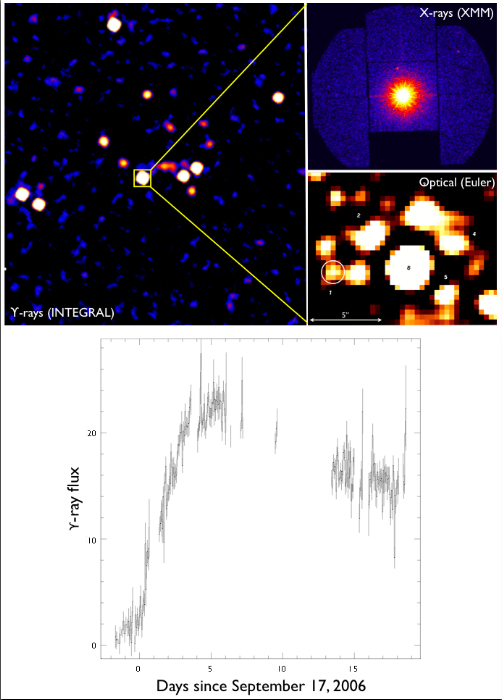
 Credit: R. Walter et al., 2006; ESA
Credit: R. Walter et al., 2006; ESA
New X-ray New Star
Who unfixed the stars? Stella novae, or "new stars", appear then disappear, the firmament not so firm. The first such novae discovered was Tycho's supernova in 1572. But this nova was not a nova as astronomers now term such objects. Astronomers define a nova as a star which undergoes a sudden, dramatic increase in brightness, then fades to obscurity, without destroying the star. Thus the first nova discovered was not a nova at all since Tycho's supernova was really a catastrophic destruction of a star. Now astronomers, using the INTEGRAL Gamma-ray observatory, have found a new nova, of the X-ray variety. This nova, called IGR J17497-2821, was found by INTEGRAL during a program to scan the center of the Milky Way. The INTEGRAL image (obtained by the IBIS/ISGRI instrument) is shown above, upper left, while hte variation of X-ray brightness from this X-ray nova is shown at the bottom of the image. On the right is an X-ray image of the star from the XMM-Newton X-ray observatory, and an optical image of the star from the Swiss "Leonhard Euler" telescope in La Silla, Chile. This X-ray nova is believed to be a Black Hole which suddenly entered an active state.
<
HEA Dictionary ● Archive
● Search HEAPOW
● Other Languages
● HEAPOW on Facebook
● Download all Images
● Education ● HEAD
>
Each week the HEASARC
brings you new, exciting and beautiful images from X-ray and Gamma ray
astronomy. Check back each week and be sure to check out the HEAPOW archive!
Page Author: Dr. Michael F. Corcoran
Last modified Monday, 26-Feb-2024 17:21:49 EST


